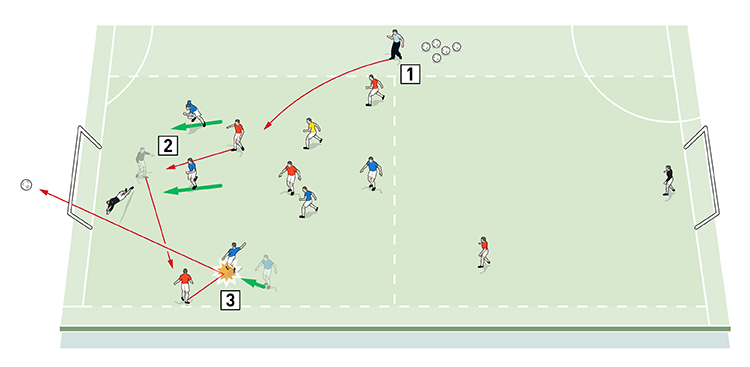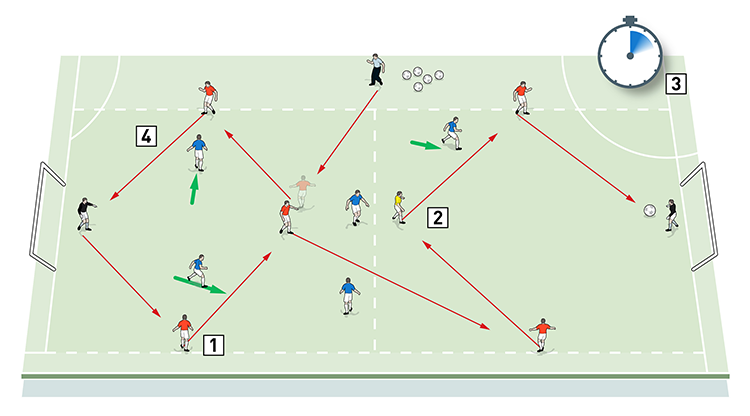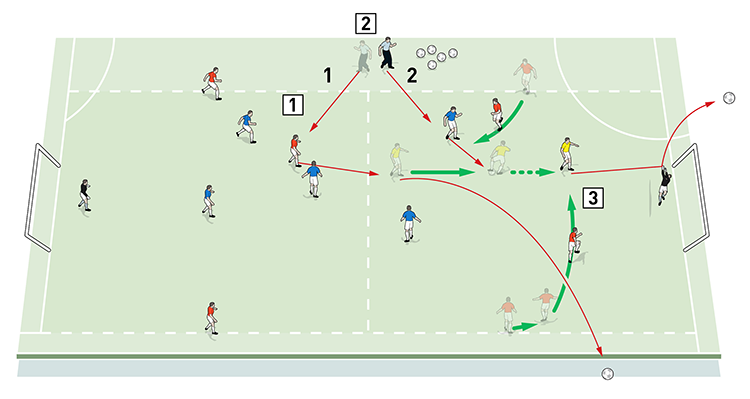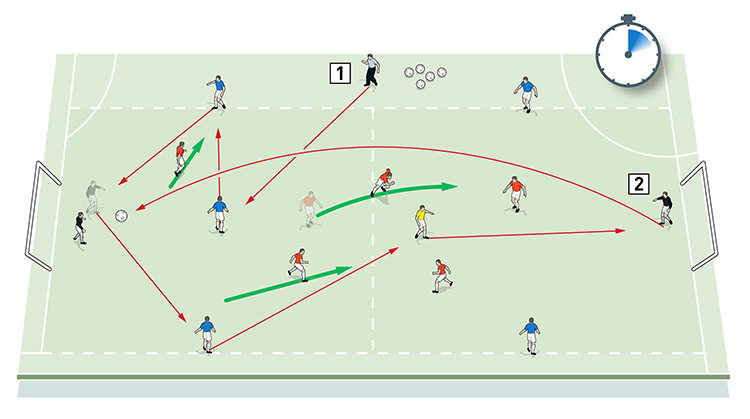Quick transitions
For the team in possession, this session is all about keeping the ball by making the pitch big and reacting quickly to the loss of possession. For the team out of possession, it’s about making the pitch small and working together to win the ball and then trying to score. To make it really engaging for the players, I’ve made it a competitive game and I like to keep score so players know who’s winning and who’s losing.

| Area | Up to 45 x 15 yards |
| Equipment | Balls, bibs, cones, 2 goals |
| No. of Players | Up to 11 players + 2 goalkeepers |
| Session Time |
Passing practice: 15mins, Transition game: 20mins |
For the team in possession, this session is all about keeping the ball by making the pitch big and reacting quickly to the loss of possession. For the team out of possession, it’s about making the pitch small and working together to win the ball and then trying to score.
To make it really engaging for the players, I’ve made it a competitive game and I like to keep score so players know who’s winning and who’s losing.
As a session it also encompasses so many other elements needed for match day, such as keeping the ball by passing, dribbling and working together, and it works on reactions and good finishing. It is also great for the goalkeepers, who have to react quickly and use their feet.
I try to run this session at every Wales training camp because there are so many things in the practice that I want to see players doing in the games.
After the transition activity, I would finish the session with an 11v11 game or a small-sided game.
PASSING PRACTICE
We set up in an area of 25x25 yards. We’re using 10 outfield players split into two teams of four and two neutral floaters.
The coach starts the practice by playing a ball into one of the teams and they must pass to keep hold of possession with the help of the two yellow floaters, as shown [1].
1

2. The possession team pass to keep the ball with the help of the two yellow neutral floaters
3. The pressing team must try to win the ball. If they succeed, they become the new passing team
The other team should press to win the ball when out of possession. They become the new passing team when there is a turnover of possession.
TRANSITION GAME
We set up in an area of approximately 45x15 yards (or from the 18-yard line to the halfway line of the pitch with a width of 15 yards). We position a goal and a goalkeeper at each end. We’re using 11 outfield players split into two teams of five and one neutral floater.
Play starts with a pass into one of the teams from the coach. The team in possession has to keep the ball with the help of the yellow floater and the two goalkeepers, giving the team an overload of 8v5. They must keep hold of the ball for 90 seconds to score a point. The defending team must try to win possession and if they succeed they should try to score a goal in the half where they won the ball, as shown [2a]. If they score a goal it is worth one point but we want to see the team that lost the ball transition quickly to defence and stop the shot if they can.
2a

2. The red team in possession has to keep the ball with the help of the yellow floater and the two goalkeepers, giving the team an overload of 8v5
3. If the blue defending team wins possession, they must try to quickly score in the half where they won the ball. A goal is worth one point
There is a lot of turnover ball to start with but then the coaches intervene. After the initial block of free play, we then set up play so the possession team makes the pitch big. We do this by getting the players to arrange themselves with the floater and one player in the centre of the playing area and the other four players out wide, with one on each side of each half, as shown [2b]. This makes it harder for the defending team to press and win the ball because they are more spread out.
2b

2. The possession team uses the goalkeepers, the yellow floater and their one remaining team mate in the centre to help them keep the ball and switch the play
3. The possession team scores a point if they keep the ball for 90 seconds
4. The blue defending team presses but will now find it harder to win the ball because the passing team are more spread out
If the ball goes out of play, the coach plays a new ball to the defending team in the half that it goes out and they must try to score a goal quickly if they can, as shown [2c]. However, if a shot is not on, they should look to keep possession of the ball instead.
2c

2. If the ball goes out of play, the coach plays a new ball to the blue defending team in the half it goes out
3. After receiving the new ball, they must try to score quickly. Here they score with the help of the floater. But if a shot is not on, they look to keep possession instead
While the team on the ball is keeping possession, the ball can be played directly from keeper to keeper only once in each block of 90 seconds, as shown [2d].
2d

2. While trying to keep the ball, the possession team can pass directly from goalkeeper to goalkeeper only once in each block of 90 seconds
We play this game for 20 minutes, in intense blocks of 90 seconds with 45 seconds rest.
What are the key things to look for?
When passing the ball, players should be aware of the tactics needed to keep possession, so we show them how to make the space bigger. After the initial free play period, by splitting the players so there are two wide players and the keeper in each half, they can learn the importance of switching play through the floater and the remaining player in the centre.
We want to see lots of one-twos from the passing team. However, if the possession player is free and not under pressure we don’t want to see him passing to a team mate who is being marked. The possession player should wait to be closed down and then pass. We also like to see that players can dribble out of trouble if the pass is not on.
When out of possession, the defending team should work as a unit rather than pressing in ones and twos, especially when the ball is played to the keeper. If the defenders press as a unit and win the ball, they have a much better chance of scoring. On transition, we need to see players reacting quickly to get a shot off.
Editor's Picks
Attacking transitions
Deep runs in the final third
Using the goalkeeper in build-up play
Intensive boxes drill with goals
Penetrating the final third
Creating and finishing
My philosophy
Pressing initiation
Compact team movement
Coaches' Testimonials

Alan Pardew

Arsène Wenger

Brendan Rodgers

Carlos Carvalhal

José Mourinho

Jürgen Klopp

Pep Guardiola

Roy Hodgson

Sir Alex Ferguson

Steven Gerrard
Coaches' Testimonials

Gerald Kearney, Downtown Las Vegas Soccer Club

Paul Butler, Florida, USA

Rick Shields, Springboro, USA

Tony Green, Pierrefonds Titans, Quebec, Canada
Join the world's leading coaches and managers and discover for yourself one of the best kept secrets in coaching. No other training tool on the planet is written or read by the calibre of names you’ll find in Elite Soccer.
In a recent survey 92% of subscribers said Elite Soccer makes them more confident, 89% said it makes them a more effective coach and 91% said it makes them more inspired.
Get Monthly Inspiration
All the latest techniques and approaches
Since 2010 Elite Soccer has given subscribers exclusive insight into the training ground practices of the world’s best coaches. Published in partnership with the League Managers Association we have unparalleled access to the leading lights in the English leagues, as well as a host of international managers.
Elite Soccer exclusively features sessions written by the coaches themselves. There are no observed sessions and no sessions “in the style of”, just first-hand advice delivered direct to you from the coach.









